Theoretical Nanphototonics and Quantum Optics Group
Members
Dr Richard Spalding, Research Associate
Dr Chenglong Wan, Research Associate
Mr Gianluc Lui, PhD Student
Mr Adam Burgess, PhD Student
Mr Kristian Stokkereit, PhD Student
Dr Timothy Amoah, Visiting Scientist
Alumni
Dr Georgios Gkantzounis, Research Associate
Ms Ella Schneider, EPSRC Summer Student
Mr Timothy Eales, EPSRC Summer Student (currently pursuing a PhD in the Photonics and Quantum Sciences group at the University of Surrey)
Mr Richard Splading, EPSRC Summer Student (currently pursuing a PhD in the Theory and Computation group at the University of Surrey)
Mr Usman Waheed, Final Year Project (currently pursuing a PhD in the Department of Materials, Imperial Colege London)
Dr Remi Wache, KTP Research Associate, now with Université de Bretagne Occidentale
Dr Steven Sellers, PhD Student, now with Citadel
Dr Ross Maspero, PhD Student, now with Actica Consulting
Dr Zoe Bushell, PhD Student, now a teaching fellow with the Physics Department, University of Bath
Research Interests
Our research interests lie in the fields of nanophotonics, quantum optics, and spintronics. In particular, we focus on the identification of novel phenomena and functionalities in micro and nanostructured photonic materials, in implementations of linear-optical and solid-state quantum information processing in nanostructured materials, and in exploring new effects in the spin dynamics in quantum dots.
Physics and Applications of Microstructured Photonic Materials
The field of photonics has advanced tremendously recently through the development of micro and nanostructured photonic materials. An important class of such materials is represented by photonic band gap (PBG) materials that present frequency ranges over which the electromagnetic light propagation is prohibited for all directions and polarizations. These materials are the optical analogues of semiconductors. Due to their unique ability to mold the flow of light and to control the light-matter interaction, PBG materials lead to a broad new frontier both in basic science and technology. An important part of our research is aimed at developing a theoretical understanding of these materials and at the identification and design of novel functionalities. Directions of research include photonic band gap formation in disordered and quasiperiodic photonic structures, physics and applications of thermal radiation control in photonic crystals and quantum optics and all-information processing in photonic band gap architectures.
Quantum Optics in Structured Photonic Reservoirs
The engineered electromagnetic vacuum associated with microstructured photonic materials is characterized by photonic density of states exhibiting discontinuous changes as a function of frequency and by highly anisotropic electromagnetic field distribution. As a result, the conventional quantum optical formalism can not be applied to describe the light-matter interaction in these materials, and new theories are needed.
In this context, we are interested in developing generalized theoretical frameworks for open quantum systems to accurately describe the quantum optical phenomena in frequency-dependent photonic reservoirs.
Linear Optical Quantum Information Processing in Photonic Nanostructures
It was demonstrated that efficient quantum computing can be implemented using only single-photon sources, passive linear optical elements, and detectors. Optical approaches to quantum computation benefit from the lack of decoherence of photons and the relative ease with which photons may be manipulated. In this context, my research concentrates on the implementation of highly efficient single-photon sources and quantum memory devices in nanostructured photonic materials.
Nanoelectronics and Spintronics
Experimental progress over the past two
decades has made
available electronic systems with an effectively reduced
spatial
dimensionality. The ability to create and manipulate
charge and spin
populations in low-dimensional quantum systems has
generated a wide
class of spin electronic (spintronics) applications. Our
research in
this area deals with the electronic and spins properties
of quantum
dots and their relevance for technological applications.
Recent Results and Major Research Accomplishments
Hyperuniform Photonic Band Gap Materials
Designer disordered materials with large complete photonic band gaps
Marian Florescu, Salvatore Torquato, and Paul Steinhardt, "Designer disordered materials with large complete photonic band gaps",, Proceedings of the National Academy of Sciences 106, 20658 (2009).
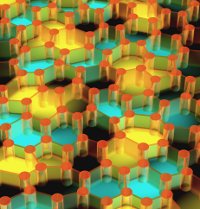 Until recently, the only materials
known to have sizeable complete photonic band gaps were
photonic crystals, periodic structures, and it was
generally assumed that long-range periodic order was
instrumental in the PBG formation. We have discovered a
new class of materials with large complete band gaps,
namely, hyperuniform non-crystallographic
micro-structures. This class of materials characterized
by suppressed density fluctuations (hyperuniformity)
includes highly-isotropic, translationally-disordered
structures. Due to their distinctive optical and
structural properties, non-crystallographic PBG
materials are expected to facilitate unprecedented
capabilities for controlling light, such as waveguiding
with arbitrary bending angle and highly-efficient
isotropic emission, with great impact for information
processing, energy harvesting, sensing, and lighting
applications.
Until recently, the only materials
known to have sizeable complete photonic band gaps were
photonic crystals, periodic structures, and it was
generally assumed that long-range periodic order was
instrumental in the PBG formation. We have discovered a
new class of materials with large complete band gaps,
namely, hyperuniform non-crystallographic
micro-structures. This class of materials characterized
by suppressed density fluctuations (hyperuniformity)
includes highly-isotropic, translationally-disordered
structures. Due to their distinctive optical and
structural properties, non-crystallographic PBG
materials are expected to facilitate unprecedented
capabilities for controlling light, such as waveguiding
with arbitrary bending angle and highly-efficient
isotropic emission, with great impact for information
processing, energy harvesting, sensing, and lighting
applications.
High-Q optical cavities in hyperuniform disordered materials
Timothy Amoah and Marian Florescu, "High-Q optical cavities in hyperuniform disordered materials",, Physical Review B, Rapid Communications 91, 020201(R) (2015); editors suggestion.
 We introduce
designs for high-Q photonic cavities in slab
architectures in hyperuniform disordered solids
displaying isotropic band gaps. Despite their
disordered character, hyperuniform disordered
structures have the ability to tightly confine the
transverse electric-polarized radiation in slab
configurations that are readily fabricable. The
architectures are based on carefully designed local
modifications of otherwise unperturbed hyperuniform
dielectric structures. We identify a wide range of
confined cavity modes, which can be classified
according to their approximate symmetry (monopole,
dipole, quadrupole, etc.) of the confined
electromagnetic wave pattern. We demonstrate that
quality factors Q>10^9 can be achieved for purely
two-dimensional structures, and that for
three-dimensional finite-height photonic slabs,
quality factors Q>20,000 can be maintained.
We introduce
designs for high-Q photonic cavities in slab
architectures in hyperuniform disordered solids
displaying isotropic band gaps. Despite their
disordered character, hyperuniform disordered
structures have the ability to tightly confine the
transverse electric-polarized radiation in slab
configurations that are readily fabricable. The
architectures are based on carefully designed local
modifications of otherwise unperturbed hyperuniform
dielectric structures. We identify a wide range of
confined cavity modes, which can be classified
according to their approximate symmetry (monopole,
dipole, quadrupole, etc.) of the confined
electromagnetic wave pattern. We demonstrate that
quality factors Q>10^9 can be achieved for purely
two-dimensional structures, and that for
three-dimensional finite-height photonic slabs,
quality factors Q>20,000 can be maintained.
Isotropic band gaps and freeform waveguides observed in hyperuniform disordered photonic solids
Weining Man, Marian Florescu, Eric Paul Williamson, Yingquan He, Seyed Reza Hashemizad, Brian YC Leung, Devin Robert Liner, Salvatore Torquato, Paul M Chaikin, Paul J Steinhardt, "Isotropic band gaps and freeform waveguides observed in hyperuniform disordered photonic solids",, Proceedings of the National Academy of Sciences 110, 15886 (2013).
 Recently,
disordered photonic media and random textured
surfaces have attracted increasing attention as
strong light diffusers with broadband and wide-angle
properties. We report the experimental realization
of an isotropic complete photonic band gap (PBG) in
a 2D disordered dielectric structure. This structure
is designed by a constrained optimization method,
which combines advantages of both isotropy due to
disorder and controlled scattering properties due to
low-density fluctuations (hyperuniformity) and
uniform local topology. Our experiments use a
modular design composed of Al2O3 walls and cylinders
arranged in a hyperuniform disordered network. We
observe a complete PBG in the microwave region, in
good agreement with theoretical simulations, and
show that the intrinsic isotropy of this unique
class of PBG materials enables remarkable design
freedom, including the realization of waveguides
with arbitrary bending angles impossible in photonic
crystals. This experimental verification of a
complete PBG and realization of functional defects
in this unique class of materials demonstrate their
potential as building blocks for precise
manipulation of photons in planar optical
microcircuits and has implications for disordered
acoustic and electronic band gap materials.
Recently,
disordered photonic media and random textured
surfaces have attracted increasing attention as
strong light diffusers with broadband and wide-angle
properties. We report the experimental realization
of an isotropic complete photonic band gap (PBG) in
a 2D disordered dielectric structure. This structure
is designed by a constrained optimization method,
which combines advantages of both isotropy due to
disorder and controlled scattering properties due to
low-density fluctuations (hyperuniformity) and
uniform local topology. Our experiments use a
modular design composed of Al2O3 walls and cylinders
arranged in a hyperuniform disordered network. We
observe a complete PBG in the microwave region, in
good agreement with theoretical simulations, and
show that the intrinsic isotropy of this unique
class of PBG materials enables remarkable design
freedom, including the realization of waveguides
with arbitrary bending angles impossible in photonic
crystals. This experimental verification of a
complete PBG and realization of functional defects
in this unique class of materials demonstrate their
potential as building blocks for precise
manipulation of photons in planar optical
microcircuits and has implications for disordered
acoustic and electronic band gap materials.
go to top
Complete band gaps in two-dimensional photonic quasicrystals
Marian Florescu, Salvatore Torquato, and Paul Steinhardt, "Complete band gaps in two-dimensional photonic quasicrystals", Physical Review B 80, 155112 (2009).
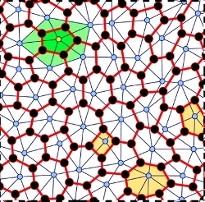 In photonic
crystals, the opening of the PBG is understood to be
governed by the synergetic interplay between Bragg
scattering resonances of the periodic dielectric
array and the Mie resonances of individual
dielectric scattering centers. A similar combination
of scattering mechanisms is possible in photonic
quasicrystals, in which the dielectric materials are
arranged in a pattern with long-range quasiperiodic
translational order. The photonic band gaps in
quasiperiodic structures are considerably more
isotropic and may open for lower dielectric contrast
required. We have introduced an optimization method
to design examples of photonic quasicrystals with
substantial, complete photonic band gaps. The method
can be applied to photonic quasicrystals with
arbitrary rotational symmetry, and we illustrate it
for fivefold and eightfold symmetric
quasicrystals. The optimized band gaps are highly
isotropic, which may offer advantages over photonic
crystals for certain applications.
In photonic
crystals, the opening of the PBG is understood to be
governed by the synergetic interplay between Bragg
scattering resonances of the periodic dielectric
array and the Mie resonances of individual
dielectric scattering centers. A similar combination
of scattering mechanisms is possible in photonic
quasicrystals, in which the dielectric materials are
arranged in a pattern with long-range quasiperiodic
translational order. The photonic band gaps in
quasiperiodic structures are considerably more
isotropic and may open for lower dielectric contrast
required. We have introduced an optimization method
to design examples of photonic quasicrystals with
substantial, complete photonic band gaps. The method
can be applied to photonic quasicrystals with
arbitrary rotational symmetry, and we illustrate it
for fivefold and eightfold symmetric
quasicrystals. The optimized band gaps are highly
isotropic, which may offer advantages over photonic
crystals for certain applications.
Unfolding the band structure of non-crystalline photonic band gap materials
Samuel Tsitrin, Eric Paul Williamson, Timothy Amoah, Geev Nahal, Ho Leung Chan, Marian Florescu, and Weining Man, "Unfolding the band structure of non-crystalline photonic band gap materials", Scientific Reports 5, 13301(R) (2015).
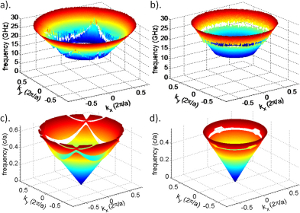 Non-crystalline
photonic band gap (PBG) materials have received
increasing attention, and sizeable PBGs have been
reported in quasi-crystalline structures and, more
recently, in disordered structures. Band structure
calculations for periodic structures produce
accurate dispersion relations, which determine group
velocities, dispersion, density of states and
iso-frequency surfaces, and are used to predict a
wide-range of optical phenomena including light
propagation, excited-state decay rates, temporal
broadening or compression of ultrashort pulses and
complex refraction phenomena. However, band
calculations for non-periodic structures employ
large super-cells of hundreds to thousands building
blocks, and provide little useful information other
than the PBG central frequency and width. Using
stereolithography, we construct cm-scale disordered
PBG materials and perform microwave transmission
measurements, as well as finite-difference
time-domain (FDTD) simulations. The photonic
dispersion relations are reconstructed from the
measured and simulated phase data. Our results
demonstrate the existence of sizeable PBGs in these
disordered structures and provide detailed
information of the effective band diagrams,
dispersion relation, iso-frequency contours, and
their angular dependence. Slow light phenomena are
also observed in these structures near gap
frequencies. This study introduces a powerful tool
to investigate photonic properties of
non-crystalline structures and provides important
effective dispersion information, otherwise
difficult to obtain.
Non-crystalline
photonic band gap (PBG) materials have received
increasing attention, and sizeable PBGs have been
reported in quasi-crystalline structures and, more
recently, in disordered structures. Band structure
calculations for periodic structures produce
accurate dispersion relations, which determine group
velocities, dispersion, density of states and
iso-frequency surfaces, and are used to predict a
wide-range of optical phenomena including light
propagation, excited-state decay rates, temporal
broadening or compression of ultrashort pulses and
complex refraction phenomena. However, band
calculations for non-periodic structures employ
large super-cells of hundreds to thousands building
blocks, and provide little useful information other
than the PBG central frequency and width. Using
stereolithography, we construct cm-scale disordered
PBG materials and perform microwave transmission
measurements, as well as finite-difference
time-domain (FDTD) simulations. The photonic
dispersion relations are reconstructed from the
measured and simulated phase data. Our results
demonstrate the existence of sizeable PBGs in these
disordered structures and provide detailed
information of the effective band diagrams,
dispersion relation, iso-frequency contours, and
their angular dependence. Slow light phenomena are
also observed in these structures near gap
frequencies. This study introduces a powerful tool
to investigate photonic properties of
non-crystalline structures and provides important
effective dispersion information, otherwise
difficult to obtain.
Experimental observation of photonic bandgaps in hyperuniform disordered materialExperimental observation of photonic bandgaps in hyperuniform disordered material
Weining Man, Marian Florescu, Kazue Matsuyama, Polin Yadak, Geev Nahal, Seyed Hashemizad, Eric Williamson, Paul Steinhardt, Salvatore Torquato, and Paul Chaikin, "Photonic band gap in isotropic hyperuniform disordered solids with low dielectric contrast",Optics Express 21, 19972 (2013).
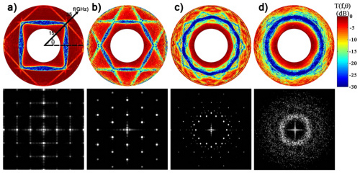 We report the
first experimental demonstration of a
TE-polarization photonic band gap (PBG) in a 2D
isotropic hyperuniform disordered solid (HUDS) made
of dielectric media with a dielectric index contrast
of 1.6:1, very low for PBG formation. The solid is
composed of a connected network of dielectric walls
enclosing air-filled cells. Direct comparison with
photonic crystals and quasicrystals permitted us to
investigate band-gap properties as a function of
increasing rotational isotropy. We present results
from numerical simulations proving that the PBG
observed experimentally for HUDS at low index
contrast has zero density of states. The PBG is
associated with the energy difference between
complementary resonant modes above and below the
gap, with the field predominantly concentrated in
the air or in the dielectric. The intrinsic isotropy
of HUDS may offer unprecedented flexibilities and
freedom in applications (i. e. defect architecture
design) not limited by crystalline symmetries.
We report the
first experimental demonstration of a
TE-polarization photonic band gap (PBG) in a 2D
isotropic hyperuniform disordered solid (HUDS) made
of dielectric media with a dielectric index contrast
of 1.6:1, very low for PBG formation. The solid is
composed of a connected network of dielectric walls
enclosing air-filled cells. Direct comparison with
photonic crystals and quasicrystals permitted us to
investigate band-gap properties as a function of
increasing rotational isotropy. We present results
from numerical simulations proving that the PBG
observed experimentally for HUDS at low index
contrast has zero density of states. The PBG is
associated with the energy difference between
complementary resonant modes above and below the
gap, with the field predominantly concentrated in
the air or in the dielectric. The intrinsic isotropy
of HUDS may offer unprecedented flexibilities and
freedom in applications (i. e. defect architecture
design) not limited by crystalline symmetries.
Photonic Band Gap Materials: Physics and Applications
Fast Assembly of Gold Nanoparticles in Large-Area 2D Nanogrids Using a One-Step, Near-Infrared Radiation-Assisted Evaporation Process
André Utgenannt, Ross Maspero, Andrea Fortini, Rebecca Turner†, Marian Florescu, Christopher Jeynes, Antonios G. Kanaras, Otto L. Muskens, Richard P. Sear, and Joseph L. Keddie, "Fast Assembly of Gold Nanoparticles in Large-Area 2D Nanogrids Using a One-Step, Near-Infrared Radiation-Assisted Evaporation Process", ACS Nano, 10 (2), 2232 (2016).
 When fabricating photonic
crystals from suspensions in volatile liquids using
the horizontal deposition method, the conventional
approach is to evaporate slowly to increase the time
for particles to settle in an ordered, periodic
close-packed structure. Here, we show that the
greatest ordering of 10 nm aqueous gold nanoparticles
(AuNPs) in a template of larger spherical polymer
particles (mean diameter of 338 nm) is achieved with
very fast water evaporation rates obtained with
near-infrared radiative heating. Fabrication of arrays
over areas of a few cm2 takes only 7 min. The assembly
process requires that the evaporation rate is fast
relative to the particles’ Brownian diffusion. Then a
two-dimensional colloidal crystal forms at the falling
surface, which acts as a sieve through which the AuNPs
pass, according to our Langevin dynamics computer
simulations. With sufficiently fast evaporation rates,
we create a hybrid structure consisting of a
two-dimensional AuNP nanoarray (or “nanogrid”) on top
of a three-dimensional polymer opal. The process is
simple, fast, and one-step. The interplay between the
optical response of the plasmonic Au nanoarray and the
microstructuring of the photonic opal results in
unusual optical spectra with two extinction peaks,
which are analyzed via finite-difference time-domain
method simulations. Comparison between experimental
and modeling results reveals a strong interplay of
plasmonic modes and collective photonic effects,
including the formation of a high-order stopband and
slow-light-enhanced plasmonic absorption. The
structures, and hence their optical signatures, are
tuned by adjusting the evaporation rate via the
infrared power density.
When fabricating photonic
crystals from suspensions in volatile liquids using
the horizontal deposition method, the conventional
approach is to evaporate slowly to increase the time
for particles to settle in an ordered, periodic
close-packed structure. Here, we show that the
greatest ordering of 10 nm aqueous gold nanoparticles
(AuNPs) in a template of larger spherical polymer
particles (mean diameter of 338 nm) is achieved with
very fast water evaporation rates obtained with
near-infrared radiative heating. Fabrication of arrays
over areas of a few cm2 takes only 7 min. The assembly
process requires that the evaporation rate is fast
relative to the particles’ Brownian diffusion. Then a
two-dimensional colloidal crystal forms at the falling
surface, which acts as a sieve through which the AuNPs
pass, according to our Langevin dynamics computer
simulations. With sufficiently fast evaporation rates,
we create a hybrid structure consisting of a
two-dimensional AuNP nanoarray (or “nanogrid”) on top
of a three-dimensional polymer opal. The process is
simple, fast, and one-step. The interplay between the
optical response of the plasmonic Au nanoarray and the
microstructuring of the photonic opal results in
unusual optical spectra with two extinction peaks,
which are analyzed via finite-difference time-domain
method simulations. Comparison between experimental
and modeling results reveals a strong interplay of
plasmonic modes and collective photonic effects,
including the formation of a high-order stopband and
slow-light-enhanced plasmonic absorption. The
structures, and hence their optical signatures, are
tuned by adjusting the evaporation rate via the
infrared power density.
Thermal radiation from finite photonic crystals
Christian Schuler, Christian Wolff, Kurt Busch, and Marian Florescu, "Thermal radiation from finite photonic crystals", Applied Physics Letters 95, 241103 (2009).
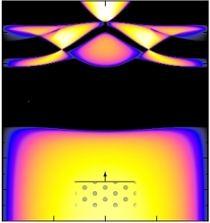 We have developed a microscopic
theory of thermal emission from finite-sized photonic
crystals and show that the directional spectral
emissivity and related quantities can be evaluated via
standard bandstructure computations without any
approximation. We then identify the physical
mechanisms through which interfaces modify the
potentially super-Planckian radiation flow inside
infinite photonic crystals, such that thermal emission
from finite-sized samples is consistent with the
fundamental limits set by Planck's law. As an
application, we further demonstrate that a judicious
choice of a photonic crystal's surface termination
facilitates considerable control over both the
spectral and angular thermal emission properties.
We have developed a microscopic
theory of thermal emission from finite-sized photonic
crystals and show that the directional spectral
emissivity and related quantities can be evaluated via
standard bandstructure computations without any
approximation. We then identify the physical
mechanisms through which interfaces modify the
potentially super-Planckian radiation flow inside
infinite photonic crystals, such that thermal emission
from finite-sized samples is consistent with the
fundamental limits set by Planck's law. As an
application, we further demonstrate that a judicious
choice of a photonic crystal's surface termination
facilitates considerable control over both the
spectral and angular thermal emission properties.
Thermal radiation in photonic crystals
Marian Florescu, Kurt Busch and Jonathan P. Dowling, "Thermal radiation in photonic crystals", Physical Review B Rapid Communications 75, 201101 (R) (2007).
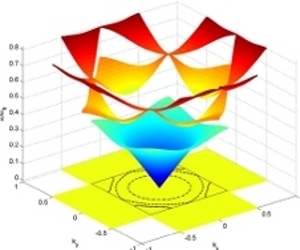 We analyze the properties of
thermal radiation in photonic crystals and show that the
spectral
energy density, the spectral intensity, and the spectral
hemispherical
power are only limited by the total number of available
photonic states
and their propagation characteristics. In addition, we
show that the
central quantity that determines these thermal radiation
characteristics is the area of the isofrequency surfaces
and not the
photonic density of states as it is generally assumed.
Through the
presence of partial or complete photonic band gaps and
the associated
spectral and angular redistribution of photonic states,
it is possible
to obtain propagation directions along which thermal
photon focusing
effects appear.
We analyze the properties of
thermal radiation in photonic crystals and show that the
spectral
energy density, the spectral intensity, and the spectral
hemispherical
power are only limited by the total number of available
photonic states
and their propagation characteristics. In addition, we
show that the
central quantity that determines these thermal radiation
characteristics is the area of the isofrequency surfaces
and not the
photonic density of states as it is generally assumed.
Through the
presence of partial or complete photonic band gaps and
the associated
spectral and angular redistribution of photonic states,
it is possible
to obtain propagation directions along which thermal
photon focusing
effects appear.
Improving solar cell efficiency using photonic band-gap materials
Marian Florescu, Hwang Lee, Irina Puscasu, Martin Pralle, Lucia Florescu, David Ting and Jonathan Dowling, "Improving Solar Cell Efficiency Using Photonic Band-Gap Materials", Solar Energy Materials and Solar Cells 91, 1599 (2007).
 The potential of using photonic
crystal structures for realizing highly efficient and
reliable
solar-cell devices is presented. We show that due their
ability to
modify the spectral and angular characteristics of
thermal radiation,
photonic crystals emerge as one of the leading
candidates for
frequency- and angular-selective radiating elements in
thermophotovoltaic devices. We show that employing
photonic
crystal-based angle- and frequency-selective absorbers
facilitates a
strong enhancement of the conversion efficiency of solar
cell devices
without using concentrators.
The potential of using photonic
crystal structures for realizing highly efficient and
reliable
solar-cell devices is presented. We show that due their
ability to
modify the spectral and angular characteristics of
thermal radiation,
photonic crystals emerge as one of the leading
candidates for
frequency- and angular-selective radiating elements in
thermophotovoltaic devices. We show that employing
photonic
crystal-based angle- and frequency-selective absorbers
facilitates a
strong enhancement of the conversion efficiency of solar
cell devices
without using concentrators.
Thermal emissivity in finite 3D photonic band gap crystals
Marian Florescu, Andrew Simpson, Hwang Lee and Jonathan Dowling, "Thermal emissivity in finite 3D photonic band gap crystals",Physical Review A 72, 033821 (2005).
 We study the optical properties
of a ï¬nite inverted-opal photonic crystal.
The light-matter interaction
is strongly affected by the presence of the
three-dimensional photonic
crystal and the alterations of the light emission and
absorption
processes can be used to control the thermal emissivity
and
absorptivity of the dielectric structure. Our study
reveals that the
absorption processes cause spectral broadening and
shifting of the band
edge optical resonances, and determine a strong
reduction of the
photonic band gap spectral range. Our results also
suggest that is
possible to realize frequency- and angle-sensitive
photonic crystal
absorbers/emitters.
We study the optical properties
of a ï¬nite inverted-opal photonic crystal.
The light-matter interaction
is strongly affected by the presence of the
three-dimensional photonic
crystal and the alterations of the light emission and
absorption
processes can be used to control the thermal emissivity
and
absorptivity of the dielectric structure. Our study
reveals that the
absorption processes cause spectral broadening and
shifting of the band
edge optical resonances, and determine a strong
reduction of the
photonic band gap spectral range. Our results also
suggest that is
possible to realize frequency- and angle-sensitive
photonic crystal
absorbers/emitters.
All-optical information processing in Photonic Band Gap Materials
Resonance fluorescence in photonic band gap waveguide architectures: Engineering the vacuum for all-optical switching
Marian Florescu and Sajeev John, "Resonance fluorescence in photonic band gap waveguide architectures: Engineering the vacuum for all-optical switching", Physical Review A 69, 053810 (2004).
 We have described
the spectral
characteristics of the radiation scattered by two-level
atoms (quantum
dots) driven by a strong external field, and coupled to
a photonic
crystal radiation reservoir. In the presence of strong
variations with
the frequency of the photonic reservoir density of
states, the atomic,
Mollow, sideband components of the scattered intensity
can be strongly
modified. Consequently, a weak optical probe field
experiences a
substantial differential gain in response to slight
variations in the
intensity of an optical driving field. We have suggested
that these
effects may be of relevance to all-optical transistor
action in
photonic crystals. Using a specific photonic crystal
heterostructure,
we suggest that an all-optical microtransistor based on
photonic
crystals may operate at less than 100 nW switching
threshold power.
We have described
the spectral
characteristics of the radiation scattered by two-level
atoms (quantum
dots) driven by a strong external field, and coupled to
a photonic
crystal radiation reservoir. In the presence of strong
variations with
the frequency of the photonic reservoir density of
states, the atomic,
Mollow, sideband components of the scattered intensity
can be strongly
modified. Consequently, a weak optical probe field
experiences a
substantial differential gain in response to slight
variations in the
intensity of an optical driving field. We have suggested
that these
effects may be of relevance to all-optical transistor
action in
photonic crystals. Using a specific photonic crystal
heterostructure,
we suggest that an all-optical microtransistor based on
photonic
crystals may operate at less than 100 nW switching
threshold power.
Photonic Band Gap Materials: Towards an all-optical micro-transistor
Sajeev John and Marian Florescu, "Photonic Band Gap Materials: Towards an all-optical micro-transistor", Journal of Optics A: Pure and Applied Optics 3, S103 (2001).
 We describe all-optical transistor
action in photonic bandgap (PBG) materials doped with
active atoms and
analyse the advantages of this system over other
all-optical transistor
proposals. In the presence of a PBG material, a coherent
laser beam
with the frequency slightly detuned from the resonant
atomic transition
frequency can drive a collection of two-level atoms to
an almost
totally inverted state, a phenomenon strictly forbidden
in ordinary
vacuum. By varying the laser field intensity in the
neighbourhood of a
threshold value, it is possible to drive the atomic
system through a
transition from states in which the atoms populate
preferentially the
ground level to almost totally inverted states. In this
process, the
atomic system switches from a passive medium (highly
absorptive) to a
active medium (highly amplifying). The large
differential gain
exhibited by the atomic medium is very robust with
respect to
nonradiative relaxation and dephasing mechanisms.
We describe all-optical transistor
action in photonic bandgap (PBG) materials doped with
active atoms and
analyse the advantages of this system over other
all-optical transistor
proposals. In the presence of a PBG material, a coherent
laser beam
with the frequency slightly detuned from the resonant
atomic transition
frequency can drive a collection of two-level atoms to
an almost
totally inverted state, a phenomenon strictly forbidden
in ordinary
vacuum. By varying the laser field intensity in the
neighbourhood of a
threshold value, it is possible to drive the atomic
system through a
transition from states in which the atoms populate
preferentially the
ground level to almost totally inverted states. In this
process, the
atomic system switches from a passive medium (highly
absorptive) to a
active medium (highly amplifying). The large
differential gain
exhibited by the atomic medium is very robust with
respect to
nonradiative relaxation and dephasing mechanisms.
Linear Optical Quantum Information Processing in Photonic Nanostructures
Single photons on demand from 3D photonic band-gap structures
Marian Florescu, Stefan Scheel, Hartmut Haeffner, Hwang Lee, Dmitry V.Strekalov, Peter L. Knight, Jonathan P. Dowling, "Single photons on demand from 3D photonic band-gap structures", Europhysics Letters 69 (6), 945 (2005).
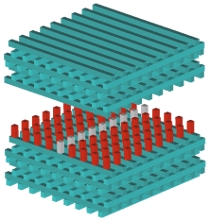 We describe a practical
implementation of a photon gun based on stimulated
Raman adiabatic
passage pumping and the strong enhancement of the
photonic density of
states in a photonic band-gap material. This device
allows
deterministic and unidirectional production of single
photons with a
high repetition rate of the order of 100 kHz. We also
discuss specific
3D photonic micro-structure architectures in which our
model can be
realized and the feasibility of implementing such a
device using Er
ions that produce single photons at the telecom
wavelength of 1.55 μm.
We describe a practical
implementation of a photon gun based on stimulated
Raman adiabatic
passage pumping and the strong enhancement of the
photonic density of
states in a photonic band-gap material. This device
allows
deterministic and unidirectional production of single
photons with a
high repetition rate of the order of 100 kHz. We also
discuss specific
3D photonic micro-structure architectures in which our
model can be
realized and the feasibility of implementing such a
device using Er
ions that produce single photons at the telecom
wavelength of 1.55 μm.
Quantum memory devices
Federico M. Spedalieri, Hwang Lee, Marian Florescu, Kishor Kapale, U Yurtsever, Jonathan Dowling, "Exploiting the quantum Zeno effect to beat photon loss in linear optical quantum information processors", Optics Communications 254, 374 (2005).
 We devise a new technique to
enhance transmission of quantum information through
linear optical
quantum information processors. The idea is based on
applying the
Quantum Zeno effect to the process of photon
absorption. By frequently
monitoring the presence of the photon through a
quantum non-demolition
(QND) measurement the absorption is suppressed.
Quantum information is
encoded in the polarization degrees of freedom and is
therefore not
affected by the measurement. Some implementations of
the QND
measurement are proposed. components.
We devise a new technique to
enhance transmission of quantum information through
linear optical
quantum information processors. The idea is based on
applying the
Quantum Zeno effect to the process of photon
absorption. By frequently
monitoring the presence of the photon through a
quantum non-demolition
(QND) measurement the absorption is suppressed.
Quantum information is
encoded in the polarization degrees of freedom and is
therefore not
affected by the measurement. Some implementations of
the QND
measurement are proposed. components.
Quantum Optics in Structured Photonic Reservoirs
Single atom switching in photonic band gap materials
Marian Florescu and Sajeev John, "Single-atom switching in photonic crystals", Physical Review A 64, 033801 (2001).
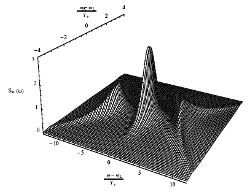 We have investigated the role of the
first non-Markovian corrections to the resonance
fluorescence in photonic crystals, using a
perturbative expansion of the Heisenberg equations of
motion in powers of the atom-field coupling strength.
Our method recaptures the physics of the photon-atom
bound state in the presence of a full photonic band
gap (PBG). For the anisotropic three-dimensional PBG,
it predicts fundamentally new features in the
resonance fluorescence, such as atomic population
inversion and switching behaviour in a two-level atom
for moderate values of the applied field. The
magnitude of the switching depends sensitively on the
external laser field intensity and the detuning of its
frequency with respect to atomic resonant frequency.
The robustness of these effects against non-radiative
decay and dephasing mechanisms of the atomic system is
also investigated.
We have investigated the role of the
first non-Markovian corrections to the resonance
fluorescence in photonic crystals, using a
perturbative expansion of the Heisenberg equations of
motion in powers of the atom-field coupling strength.
Our method recaptures the physics of the photon-atom
bound state in the presence of a full photonic band
gap (PBG). For the anisotropic three-dimensional PBG,
it predicts fundamentally new features in the
resonance fluorescence, such as atomic population
inversion and switching behaviour in a two-level atom
for moderate values of the applied field. The
magnitude of the switching depends sensitively on the
external laser field intensity and the detuning of its
frequency with respect to atomic resonant frequency.
The robustness of these effects against non-radiative
decay and dephasing mechanisms of the atomic system is
also investigated.
Resonance Fluorescence in a Frequency Dependent Photonic Reservoir: An Exact Multi-Photon Scattering Theory
Marian Florescu, Sajeev John and Valery Rupasov, "Resonance Fluorescence in a Frequency Dependent Photonic Reservoir: An Exact Multi-Photon Scattering Theory", Preprint.
 We have developed an exact theory of
resonance fluorescence of a two-level atom embedded in
a frequency dependent photonic reservoir exhibiting
sharp features or gaps in the local density of states.
The fluorescence is treated as scattering of incident
photons on the atomic system and we have derived a
solution of the multiphoton scattering problem without
recourse to other approximations. Near a sharp feature
in the photonic density of states, the non-Markovian
character of radiative decay invalidates the usual
optical Bloch equations approach, but the multiphoton
scattering approach developed here is still applicable
due to a hidden symmetry of the scattering problem.
We have developed an exact theory of
resonance fluorescence of a two-level atom embedded in
a frequency dependent photonic reservoir exhibiting
sharp features or gaps in the local density of states.
The fluorescence is treated as scattering of incident
photons on the atomic system and we have derived a
solution of the multiphoton scattering problem without
recourse to other approximations. Near a sharp feature
in the photonic density of states, the non-Markovian
character of radiative decay invalidates the usual
optical Bloch equations approach, but the multiphoton
scattering approach developed here is still applicable
due to a hidden symmetry of the scattering problem.
Lateral Quantum Dots
Spin relaxation in lateral quantum dots
Marian Florescu and Pawel Hawrylak, "Spin relaxation in lateral quantum dots: Effects of spin-orbit interaction", Physical Review B 73, 045304 (2006).
 Using exact diagonalization
techniques, we investigate the influence of the
spin-orbit interaction on the energy levels of a
two-electron droplet and we show that the spin-orbit
interaction strongly affects the expectation values of
the total and z-projection spins of the two-electron
system. We then evaluate the energy relaxation rates
for the two-electron droplet through the emission of
longitudinal acoustic phonons Our study shows that the
spin-orbit interaction provides an effective coupling
between the spin-polarized triplet states and the
singlet state, and the calculated scattering rates
reveal a microsecond time scale. The relaxation
mechanism presents a built-in magnetic field
asymmetry, in qualitative agreement with experimental
findings.
Using exact diagonalization
techniques, we investigate the influence of the
spin-orbit interaction on the energy levels of a
two-electron droplet and we show that the spin-orbit
interaction strongly affects the expectation values of
the total and z-projection spins of the two-electron
system. We then evaluate the energy relaxation rates
for the two-electron droplet through the emission of
longitudinal acoustic phonons Our study shows that the
spin-orbit interaction provides an effective coupling
between the spin-polarized triplet states and the
singlet state, and the calculated scattering rates
reveal a microsecond time scale. The relaxation
mechanism presents a built-in magnetic field
asymmetry, in qualitative agreement with experimental
findings.
Spin-orbit interaction in lateral quantum dots
Marian Florescu, Sergei Dickman, Mariusz Ciorga, Andy Sachrajda and Pawel Hawrylak, "Spin-orbit interaction and spin relaxation in lateral quantum dots", Physica E 22, 414 (2004).
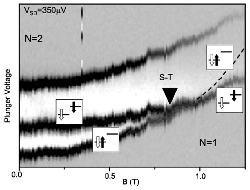 Our study was motivated by puzzling
results of high source-drain transport measurements of
singlet-triplet transition of two electrons in lateral
and vertical devices that show a strong asymmetry as a
function of the applied magnetic field. We evaluate
the energy levels of a two-electron droplet in the
presence of both Dresselhaus and Rashba contributions
to the spin-orbit interaction and the energy
relaxation rates and show that transitions involving
spin singlet and unpolarized triplet states remain
forbidden even in the presence of spin-orbit
interaction.
Our study was motivated by puzzling
results of high source-drain transport measurements of
singlet-triplet transition of two electrons in lateral
and vertical devices that show a strong asymmetry as a
function of the applied magnetic field. We evaluate
the energy levels of a two-electron droplet in the
presence of both Dresselhaus and Rashba contributions
to the spin-orbit interaction and the energy
relaxation rates and show that transitions involving
spin singlet and unpolarized triplet states remain
forbidden even in the presence of spin-orbit
interaction.
